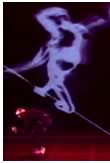September 30, 2005
motione

Bridging the Phyical-Digital Divide
motione: Using state of the art, real time motion capture technologies and motion analysis techniques, the movement of the dancers and the structures of the choreography are analyzed in real time. Through novel artificial intelligence and human-computer interaction systems, the results of the analysis informs the creation of digital graphics and sound environments that react to, accompany, enhance and comment on the choreography.
The works investigate future possibilities for interactive art works while exploring the effects of the new digital sensing, processing and creation possibilities on the human condition. They propose integrations paths that will allow these technologies to enhance and promote humanism.
The motione project of the Arts, Media and Engineering (AME) program at ASU, brings together choreographers Trisha Brown and Bill T. Jones; media artists Paul Kaiser, Shelley Eshkar and Marc Downie; composers Roger Reynolds and Curtis Bahn; lighting designer Robert Weirzel with AME artists and engineers for the creation of two ground breaking, interactive multimedia works, new motion analysis systems and interactive technologies. motione premieres on April 9th 2005 at ASU 's Galvin Playhouse.
motione is a joint project of the Arts, Media and Engineering Program through the Herberger College of Fine Arts, the Fulton School of Engineering. It is co-presented by ASU Public Events. We are grateful for support from the National Endowment for the Arts, the National Science Foundation, Motion Analysis Corporation, Lincoln Center, Arizona Public Service (APS) and City of Tempe Cultural Services.
[...]
The physical-digital divide in art
Today, a large percentage of content that is shaping our society reaches us through digitally enabled media (computers, cell phones, TV, movies). Yet, the majority of the established arts, creation, education and presentation communities concentrate solely on physical art manifestations presented in traditional venues (theaters, concert halls, galleries).
We still struggle to find effective ways to connect new forms of digital content to the maturity and sensitivity of traditional art forms. Addressing this divide by successfully integrating physical and digital art forms could raise the level of digital content and end the marginalization of traditional art.
The physical-digital divide in life
Our civilization is currently undergoing major changes. Traditionally, human beings acquired knowledge through experiential interactions with the physical world. That knowledge allowed them to better adapt to their reality and evolve.
Today, the electronic networked world is rapidly becoming an integral aspect of human reality. Our interactions with almost every element of our lives, from the weather, to our habitat, our bodies, our friends and relatives involve computation and mediated information.
However, as any dictionary would point out, knowledge results from experience. To adapt to this new world, we must bridge the gap between computational information and physical experience. We need unified experiences of the physical and computational forces that are shaping our reality.
Integrating the physical and the digital at multiple levels and dimensions
We experience the world concurrently at many different, interconnected levels, from the level of manifestation, to the level of operational structure and the level of semantics. It follows that a convincing physical-digital experience must be integrated at all those levels. All participating elements must contribute to a structurally, aesthetically and semantically coherent experience.
We also experience the world at multiple levels of time. Real time perception, short term memory, long term memory and social memory contribute to our experience. Our structural, aesthetic and semantic integrations must hold true across the multilayered dimension of time.
Finally, we experience the world in an interactive manner where our actions explore and influence our environment. Integrated physical-digital experiences require interactive digital media that allow for exploration while exhibiting adaptability.
Digital media are based on computation and our current society is deeply intertwined with computational infrastructures. It follows that structural integration of digital media into the physical world would have to rely on computation.
Creating embodied hybrid experiences
The music and visual arts communities have been working for the past two decades on creating hybrid physical digital music compositions, visual art works and installations. However, human experience of the world is embodied and multi-modal. Arts can best investigate and depict our current hybrid reality through multi-modal, interactive works that include movement. The main drawback for such works has been the difficulty of digitizing and analyzing movement.
Sampling, digital analysis and digital synthesis of sound and image are already fairly advanced. Complex processing of sound and image can be realized with good accuracy in real time. User-friendly software for interactive analysis and synthesis of sound and image are readily available.
Some of those packages (i.e. Max/MSP/Jitter) allow for the simultaneous processing of both image and sound. The tools for coherent, digital, sound-image interactive compositions are available and increasingly used in all types of settings--from installations in galleries, to jam sessions in music bars, symphonic concerts, educational settings and biodesign experiments.
Documentation and analysis of motion has until recently relied on 2D video capture that provides limited information on the spatial and kinesthetic aspects of movement and has limited capabilities in real time use.
The development of motion capture technology in the past two decades has opened up many possibilities for advanced digitization and analysis of movement. The motione project is developing techniques for advanced real time capture and analysis of movement. These motion analysis systems are being integrated with real time systems for image and sound analysis and synthesis to create unified platforms for the creation of multimodal physical-digital works. [...]
Posted by jo at September 30, 2005 11:00 AM
